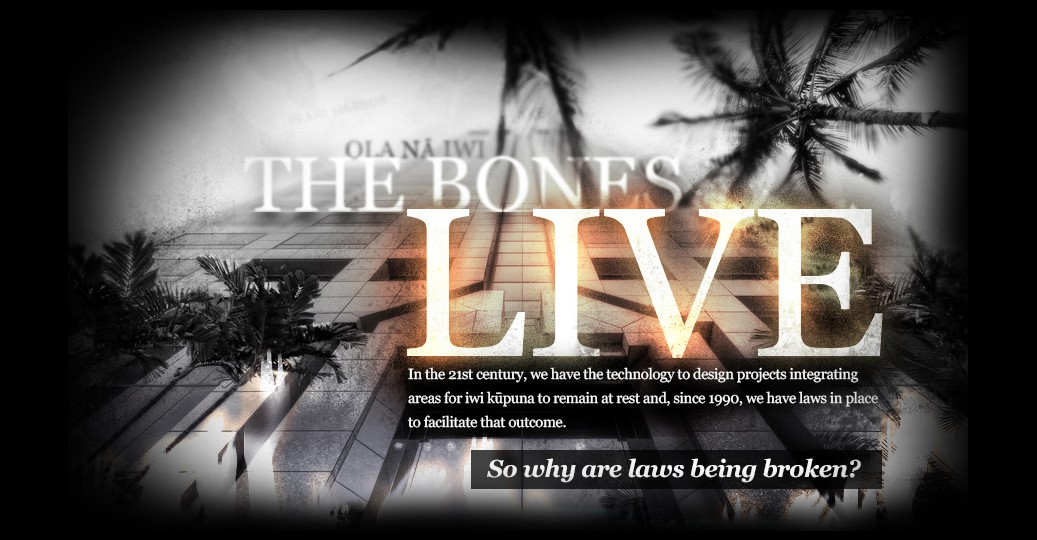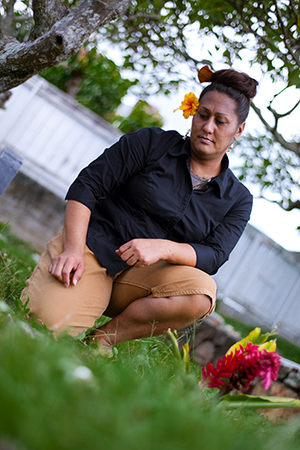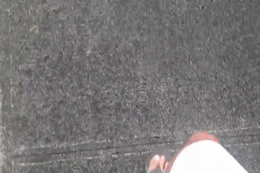
“The more we protect our burials in place, the more we protect our own sovereignty.”
Video: Dana Nāone Hall, Kaʻanohi Kaleikini, Kaleikoa Ka’eo, Hinaleimoana Wong-Kalu, and Moses K.N. Haia III speak on the topic of iwi kūpuna. 4Miles, LLC for Kamakakoʻi
On a recent weekday on Maui, a few hundred yards from one of the most beautiful beaches on the island, Dana Hall pauses for a moment to bemoan the loss of ancient burial sites to development.
For nearly three decades, this former chairwoman of the Maui County Burial Council has been a booming voice for the issue, mobilizing hundreds of residents and tapping in to statewide networks of information that could help the cause.
“What motivates me – and has been deep in everyone involved – is reverence for the things of the past that feed us now and continue on through us,” Hall said.
She sees, as Paulette Kaleikini does, many of these sacred burial sites getting bulldozed and destroyed by such land-hungry developments as hotels, shopping centers and transportation projects. It pains Kaleikini still.
But Kaleikini holds on as a pivotal figure in bringing attention to the ongoing challenges to protect and preserve the ancestral remains of Hawaiian families.
“Our kupuna is our connection to the land and when (developers) desecrate their iwi, it takes so much out of me,” Kaleikini said.
She recognizes, as Kaleikoa Ka’eo does, that the issue is larger than them as individuals. From his perspective, the issue is about preserving his cultural identity as a Hawaiian.
“Cultural identity is so important – so central that we cannot really be in a sense Hawaiian without this understanding of our iwi kūpuna,” said Kaeo, a professor at Maui Community College.
For that reason, Hinaleimoana Wong-Kalu approaches her leadership role on the O’ahu Island Burial Council with energy, enthusiasm and a sense of urgency, all bent on preserving the Hawaiian community’s say in continual improvement of land-use planning. But she is quick to add that her job isn’t to block development.
“It’s my job to speak up on behalf of iwi kūpuna,” she said. “It’s not my job to try to be an opponent to development…”
Hinaleimoana Wong-Kalu cares for her family at Puʻukamaliʻi Cemetary, a humble graveyard nestled among the one and two-story houses of ʻĀlewa. Wong-Kalu attends to the cemetary so generations from now it is not forgotten, disregarded, and swept away in future waves of development. Photo: Ruben Carrillo
“It is my job to speak up on behalf of iwi kūpuna,It is not my job to try to be an opponent to development”
In the early 1990s, Hawaiian leaders played key roles in drafting and seeking the passage of national and state legislation protecting native burials.
Like Moses Haia III, she takes hope in laws that have been established to protect unmarked burials in Hawaiʻi. As the executive director of the Native Hawaiian Legal Corporation, Moses characterized these state and federal laws as imperative to help communities across the state plan development better.
“Developers have to understand that if they don’t do it right, they are going to end up in court,”
Haia said. “And I’m going to make sure that happens.”
Five Hawaiian leaders. Five lives. Intersecting where Hawaiʻi’s cultural past meets its future. As Hawaiians, all five of these cultural descendants of iwi kūpuna lived the traditions of their ancestors, whose ancestral burial sites carry personal significance. They see disturbing these sites as doing spiritual harm to the kūpuna and their living ʻohana.
Today, in showdowns in courtrooms and planning commission meetings across the state, these Hawaiian voices embody the ongoing tension between those who seek protection for unmarked Native Hawaiian burials and those who choose not to comply with rules for development projects.
At stake are the well-being of ʻohana (living and deceased), the integrity of cultural practices, and the future of multimillion-dollar development projects.
Since the 1980s, the two sides have faced off in a series of bitter battles that have caught public attention.
1 In 2004, construction at the Wal-Mart complex on Ke‘eaumoku Street unearthed human remains.
2 In 2007, discoveries of historic Hawaiian burials, halted construction of the condo and organic foods store several times.
3 In 2012, The Hawaii Intermediate Court of Appeals ruled against Kawaiahao Church, saying that it failed to follow the State Historic Preservation Law when it unearthed hundreds of burials during construction of a new multipurpose center.
Among them was the widely-publicized construction on the Walmart complex on Keʻeaumoku Street in 2004,1 when 42 sets of human skeletal remains were unearthed after local planning officials issued permits for the project without assurance that an archeological inventory survey had been completed.
Construction was also halted on the Ward Villages Shops in 2007, when more than 60 burials had been discovered after a permit had been issued to start the project.2
In another closely watched dispute, the Hawaiʻi Intermediate Court of Appeals ruled against the Kawaiahaʻo Church in 2012, when it was determined that the State Historic Preservation Division failed to follow its own historic preservation laws by allowing Kawaiahaʻo Church to unearth more than 600 burial remains during construction of a multi-purpose center.3
Additional Reading:
A brief historical overview of burial issues
by Kēhaunani Abad, Ph.D., Archaeologist & Ethnohistorian
The fallout from these decisions has prompted vocal opposition in the Hawaiian community to laws that grant broad exemptions from land use and county zoning laws as a way to encourage private businesses to develop public lands.
But as Dana Hall points out, ancient burial sites didn’t always have the muscle of state law behind them.
In the late 1980s, the battle over a burial dune at Honokahua, Maui “changed that and did so in dramatic fashion,” Hall said.
At the center of the issue were plans to build the Ritz Carlton Hotel along the beachfront, where more than 900 burial sites were unearthed when excavation work began for the project. After the importance of the discovery was brought to light by Hall and others, the hotel was moved inland and the burials reinterred at the site.
“Unfortunately, that had to happen for the kind of awareness that got us to the point of actually providing more protection under our historic preservation law,” said Haia.
Dana Hall agrees, adding that “no one ever stood up for a thing like that before,” referring to the existence of ancient unmarked burial sites at Honokahua that were not protected by law. “No one knew how,” she said. “That’s one of the things that Honokahua changed.”
Paulette Kaleikini acknowledges that Honokahua was an eye-opener for her. “My first real understanding of desecration started with Honokahua,” she said. “Protecting our iwi kūpuna is a natural thing to do; it’s a humane thing to do. Who wouldn’t want to protect the graves of family members? And that is what we’re doing. The archeological inventory survey is the instrument that we use to move forward to protect our iwi kūpuna.”
In Hawaiʻi, an archaeological inventory survey is required before construction can begin on a development project.
If burials are discovered, the Island Burial Councils have the authority to determine how they should be handled. At the same time, if burials are found during construction, then the state Historic Preservation Division would have jurisdiction.
“I was very proud of the law when it passed,” Hall said. “That was because I knew that Hawaiʻi had the strongest law for protecting burials. And it was not just for Native Hawaiians, it was for all burials – 50 years or older.”
Haia sees the law as a welcome sign for his role in the ongoing struggle to protect ancient burial sites. “I’m responsible for making sure that they continue to hold significance,” he said. “I think that’s my obligation. It’s not just my obligation as an attorney, or the executive director of the Native Hawaiian Legal Corp., it’s my obligation as a Hawaiian.”
Kaʻeo echoes the sentiment, saying that burial sites “are places that hold great significance for our people. If we maintain and honor these places, we will maintain the highest integrity of our culture.”
Kaleikini added the stern reproach: “desecration is bad in any language or on any land. It should not be happening.”
As far as Wong-Kalu is concerned, it’s perplexing to her that — with 21st century technology – that developers aren’t designing projects to better integrate burial sites as the final resting place for iwi kūpuna. “There’s no reason why they can’t do it,” she said. “My job is to ensure that the strongest voice that I can provide will be given towards honoring and protecting our iwi kūpuna.”
Hall sums up her feelings about the issue this way: “The more we protect our burials in place, the more we protect our own sovereignty.”


